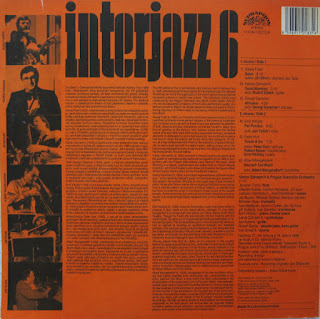I guess this is why I do this blog-- so people can give me recommendations I would never, ever have thought of. I was shocked that other people were even familiar with Ogerman, but even more thrown off by the commenter who recommended I read the long and discursive blog post dedicated to him, to be found
here on this page, which absolutely nailed it, in many ways. Every album I love was referenced there, including the Evans collaboration Symbiosis, Gate of Dreams, the Brecker City Scape, Streisand, Oscar Peterson, and then more even that I wasn't aware of. I guess everyone with a passing familiarity to jazz knows Jobim mostly today due to his constant appearance in those nuisance jazz standards that keep showing up at jazz festivals every summer in your local city (The Girl from Ipanema), what I had never realized was that my favourite Jobim album and to me his masterpiece, a 1976 opus called Urubu, was arranged by Ogerman!! So I dug it up to post it because it really belongs with the other works from him. Jobim of course was way too popular a songwriter to come up with progressive music, I mean he never needed to right, but on the second side of this collaboration, the musical world absolutely goes straight up to heaven in a ramjet-fuelled, teraton-powered, billionaire-financed, space-z rocketship that belongs in the museum of godhead eternity as far as I'm concerned-- just consider the compositional acheivement of the
Arquitetura de Morar (surprisingly to me this means architecture to live, not die, though the latter would have seemed more poetic):
Music cannot possibly, ever, get more beautiful than that, as far as I'm concerned. The whole of the second side is similar, the blogspot mentioned
Saudade do Brasil as remarkable too.
At the risk of getting into trouble I'll quote from the
blogpost, written by Steven Cerra, in part, regarding some of the albums here and in the prior post, with some editoral comments from myself:
In 1969, Claus wrote an album for Oscar Peterson titled Motions and Emotions on the MPS label. Some of it's good, some of it's commercial, and some of it is knockout, above all the chart and performance of the Jobim tune Wave. The chart is, as one might expect, exquisite, but particularly noteworthy is the extended ending, and the way Claus can build incredible tensions with rising ostinatos. It is stunning writing, and the extended closing passage an indication of an emerging method in his compositional techniques.
[Ed. It's true the ending of Wave that old chronic failing kidneysed wrinkled standard is fantastic with the churning orchestral sounds, but the real standout brilliant arrangement is
Dreamsville-- check that one song out for the most stunning piano + orchestra ever written.]
In the 1977 album Amoroso that Claus wrote for Joao Gilberto, one finds the Italian song Estate
, which means "summer." The arrangement is almost unbearably poignant. That one recording launched the tune as an international jazz standard. Then in 1979, Claus wrote Terra Brasilis (Warner Brothers) for Jobim. The album (containing another of the tunes I wrote with Jobim, Double Rainbow), came out in 1980.
[Ed. This was a bit more disappointing compared to Uluru.]
After that, Claus arranged and orchestrated only his own music, including Cityscape, featuring tenor saxophonist Michael Brecker, in 1982. In 1989 they collaborated again on Claus Ogerman featuring Michael Brecker.
But let us back up to 1976. That was the year of an album on Warner Bros entirely of Claus's compositions, a suite titled Gate of Dreams. It is marvelous, haunting, brooding, expressing that poignant Prussian melancholy that I think is the core of Claus's work. Bill Evans called the suite "a reminder of finer things." And so it is. But it presents problems to those who want to put things in labeled shoe-boxes as "classical" or "jazz" or "pops" because Claus draws on all these idioms. It's simply gorgeous, with the writing reflecting all his musical experience up to that time. And it is the shape of things to come in Claus's writing. The Gramophone critic who in 1988 couldn't find out who Claus was wrote of the Tagore Lieder. "I can only report that these seven songs are in a loose post-serial idiom." He got that right, and also the perception of their "sparse, tonal lyricism."
The post is incredibly detailed in its in-depth knowledge of everything Ogerman has written, including the first album with Evans, with Symphony Orchestra, all the way through to the Lyrical Works. The only thing missing to me is mention of the awesomely heart-breaking song
I Loved You. I guess also the song I raved about earlier called This Dream (on the Freddie Hubbard collaboration).
I would also reiterate (which he did) that the streak of melancholy and philosophy that travels through his music seems to emanate from his roots in middle-Europe.
To my utter surprise this commenter mentioned also the following album, with Danilo Perez, called
Across the Crystal Sea. (Not mentioned in the blogspot, I think?)
I say this of course because the music is classic, 100 percent, unadulterated, no sugar added, Claus Ogerman, you can see he wrote 6 out of 8 songs on there, often based on themes from classical or other composers. If you don't believe me, listen to the last and phenomenalest track:
His situation also reminds me of
Teo Macero, another formidable arranger with huge successes in the jazz world who was capable of remarkable modern composition as well, compositions that for the most part are neglected and forgotten today. I've featured so much from him on these pages too. Obviously, the personality was totally different, with Teo fully in the jazz world and the excitement of fusion.































































